Nanotechnology for Managing Rice Blast Disease: A Comprehensive Review
Abstract
1. Introduction
2. Methods
3. Results and Discussions
3.1. Metallic Nanoparticles Against Magnaporthe oryzae
3.2. Nanoemulsions of Essential Oils
3.3. Biopolymer Nanoparticles and Nanochitosan
3.4. Smart Nanocarriers for Controlled Release
3.5. Nanosensors for Rapid Diagnosis
3.6. Nanomaterials for Enhanced Host Resistance
3.7. Biosafety and Sustainability Considerations
3.8. Integration with IPM and Comparative Strategies
3.9. Limitations and Future Perspectives
4. Conclusions
Funding
Conflicts of Interest
References
- Song, J.J.; Soytong, K.; Kanokmedhakul, S. Control of rice blast disease caused by Magnaporthe oryzae by application of antifungal nanomaterials from Emericella nidulans. Plant Prot. Sci. 2021, 58, 40–48. [Google Scholar] [CrossRef]
- Banakar, S.N.; Prasannakumar, M.K.; Parivallal, P.B.; Pramesh, D.; Mahesh, H.B.; Sarangi, A.N.; Puneeth, M.E.; Patil, S.S. Rice-Magnaporthe transcriptomics reveals host defense activation induced by red seaweed-biostimulant in rice plants. Front. Genet. 2023, 14, 1132561. [Google Scholar] [CrossRef]
- Kou, Y.; Shi, H.; Qiu, J.; Tao, Z.; Wang, W. Effectors and environment modulating rice blast disease: From understanding to effective control. Trends Microbiol. 2024, 32, 1007–1020. [Google Scholar] [CrossRef]
- Nalley, L.; Tsiboe, F.; Durand-Morat, A.; Shew, A.; Thoma, G.; Wang, Z. Economic and Environmental Impact of Rice Blast Pathogen (Magnaporthe oryzae) Alleviation in the United States. PLoS ONE 2016, 11, e0167295. [Google Scholar] [CrossRef]
- Skamnioti, P.; Gurr, S.J. Against the grain: Safeguarding rice from rice blast disease. Trends Biotechnol. 2009, 27, 141–150. [Google Scholar] [CrossRef] [PubMed]
- Zhang, H.-F.; Islam, T.; Liu, W.-D. Integrated pest management programme for cereal blast fungus Magnaporthe oryzae. J. Integr. Agric. 2022, 21, 3420–3433. [Google Scholar] [CrossRef]
- Sharma, D.; Gupta, A.; Rawat, R.; Sharma, S.; Yadav, J.S.; Saxena, A. Exploring nanoformulation drug delivery of herbal actives for enhanced therapeutic efficacy: A comprehensive review. Intell. Pharm. 2025, 3, 26–34. [Google Scholar] [CrossRef]
- Yang, Y.; Zhang, Y.; Zhang, L.; Zhou, Z.; Zhang, J.; Yang, J.; Gao, X.; Chen, R.; Huang, Z.; Xu, Z.; et al. Isolation of Bacillus siamensis B-612, a Strain That Is Resistant to Rice Blast Disease and an Investigation of the Mechanisms Responsible for Suppressing Rice Blast Fungus. Int. J. Mol. Sci. 2023, 24, 8513. [Google Scholar] [CrossRef]
- Rahman, T.U.; Shah, S.; Hassan, S.; Fahad, S. Food security challenges and adaptation strategies in China amidst global climate change. J. Umm Al-Qura Univ. Appl. Sci. 2025, 1–14. [Google Scholar] [CrossRef]
- Elshafie, H.S.; Osman, A.; El-Saber, M.M.; Camele, I.; Abbas, E. Antifungal Activity of Green and Chemically Synthesized ZnO Nanoparticles against Alternaria citri, the Causal Agent Citrus Black Rot. Plant Pathol. J. 2023, 39, 265–274. [Google Scholar] [CrossRef]
- Jabran, M.; Ali, M.A.; Muzammil, S.; Zahoor, A.; Ali, F.; Hussain, S.; Muhae-Ud-Din, G.; Ijaz, M.; Gao, L. Exploring the potential of nanomaterials (NMs) as diagnostic tools and disease resistance for crop pathogens. Chem. Biol. Technol. Agric. 2024, 11, 75. [Google Scholar] [CrossRef]
- Maluin, F.N.; Hussein, M.Z. Chitosan-Based Agronanochemicals as a Sustainable Alternative in Crop Protection. Molecules 2020, 25, 1611. [Google Scholar] [CrossRef] [PubMed]
- Preeti; Sambhakar, S.; Malik, R.; Bhatia, S.; Al Harrasi, A.; Rani, C.; Saharan, R.; Kumar, S.; Geeta; Sehrawat, R.; et al. Nanoemulsion: An Emerging Novel Technology for Improving the Bioavailability of Drugs. Scientifica 2023, 2023, 6640103. [Google Scholar] [CrossRef] [PubMed]
- Vinceković, M.; Jurić, S.; Vlahoviček-Kahlina, K.; Martinko, K.; Šegota, S.; Marijan, M.; Krčelić, A.; Svečnjak, L.; Majdak, M.; Nemet, I.; et al. Novel Zinc/Silver Ions-Loaded Alginate/Chitosan Microparticles Antifungal Activity against Botrytis cinerea. Polymers 2023, 15, 4359. [Google Scholar] [CrossRef] [PubMed]
- Chaturvedi, A.; Tripathi, D.; Ranjan, R. Nano-enabled biosensors in early detection of plant diseases. Front. Nanotechnol. 2025, 7, 1545792. [Google Scholar] [CrossRef]
- Jaiswal, M.; Dudhe, R.; Sharma, P.K. Nanoemulsion: An advanced mode of drug delivery system. 3 Biotech 2014, 5, 123–127. [Google Scholar] [CrossRef]
- Le Dang, Q.; Nguyen, C.Q.; Vo, T.K.A.; Nguyen, T.T.T.; Pham, Q.D.; Nguyen, T.X.; Cao, T.H.; De Tran, Q.; Le, T.T.; Do, T.H.; et al. A botanical nanoemulsion against phytopathogenic fungi Colletotrichum sp. and Fusarium oxysporum: Preparation, in vitro and in vivo bioassay. J. Nat. Pestic. Res. 2024, 10, 100099. [Google Scholar] [CrossRef]
- Yang, W.; Zhang, H.; Li, M.; Wang, Z.; Zhou, J.; Wang, S.; Lu, G.; Fu, F. Early diagnosis of blast fungus, Magnaporthe oryzae, in rice plant by using an ultra-sensitive electrically magnetic-controllable electrochemical biosensor. Anal. Chim. Acta 2014, 850, 85–91. [Google Scholar] [CrossRef]
- Bouhadi, M.; Javed, Q.; Jakubus, M.; Elkouali, M.; Fougrach, H.; Ansar, A.; Ban, S.G.; Ban, D.; Heath, D.; Černe, M. Nanoparticles for Sustainable Agriculture: Assessment of Benefits and Risks. Agronomy 2025, 15, 1131. [Google Scholar] [CrossRef]
- Devi, K.A.; Prajapati, D.; Kumar, A.; Pal, A.; Bhagat, D.; Singh, B.R.; Adholeya, A.; Saharan, V. Smart Nano-Chitosan for Fungal Disease Control. In Nanopesticides: From Research and Development to Mechanisms of Action and Sustainable Use in Agriculture; Springer International Publishing: Cham, Switzerland, 2020; pp. 23–47. [Google Scholar] [CrossRef]
- Khan, F.; Shariq, M.; Asif, M.; Siddiqui, M.A.; Malan, P.; Ahmad, F. Green Nanotechnology: Plant-Mediated Nanoparticle Synthesis and Application. Nanomaterials 2022, 12, 673. [Google Scholar] [CrossRef]
- Sidhu, A.K.; Verma, N.; Kaushal, P.; Agrawal, S.B.; Bhatia, S. Green synthesis of polymeric nanoparticles: Agricultural applications and toxicological implications. Discov. Appl. Sci. 2025, 7, 505. [Google Scholar] [CrossRef]
- Zafar, S.; Arshad, M.F.; Khan, H.; Menahil, R.; Iqbal, L.; Prabhavathi, S.J.; Kumar, M.S.; Omar, A.F.; Shaheen, T. Nanoformulations of plant essential oils for managing mycotoxins producing fungi: An overview. Biocatal. Agric. Biotechnol. 2024, 60, 103314. [Google Scholar] [CrossRef]
- Page, M.J.; McKenzie, J.E.; Bossuyt, P.M.; Boutron, I.; Hoffmann, T.C.; Mulrow, C.D.; Shamseer, L.; Tetzlaff, J.M.; Akl, E.A.; Brennan, S.E.; et al. The PRISMA 2020 statement: An updated guideline for reporting systematic reviews. BMJ 2021, 372, 71. [Google Scholar] [CrossRef]
- Akter, R. Efficacy of Silver Nanoparticles Against Rice Blast Disease and Farmers Perception about Its Management in Bangladesh. Master’s Thesis, Swedish University of Agricultural Sciences, Alnarp, Sweden, 2019. [Google Scholar]
- Elamawi, R.M.A.; El-Shafey, R.A.S. Inhibition effects of silver nanoparticles against rice blast disease caused by Magnaporthe grisea. Egypt. J. Agric. Res. 2013, 91, 1271–1283. [Google Scholar] [CrossRef]
- Jo, Y.K.; Kim, B.H.; Jung, G. Antifungal Activity of Silver Ions and Nanoparticles on Phytopathogenic Fungi. Plant Dis. 2009, 93, 1037–1043. [Google Scholar] [CrossRef] [PubMed]
- Chen, Y.; Liu, Z.; Meng, S.; Shen, Z.; Shi, H.; Qiu, J.; Lin, F.; Zhang, S.; Kou, Y. OsCERK1 Contributes to Cupric Oxide Nanoparticles Induced Phytotoxicity and Basal Resistance against Blast by Regulating the Anti-Oxidant System in Rice. J. Fungi 2022, 9, 36. [Google Scholar] [CrossRef] [PubMed]
- Parthasarathy, R.; Jayabaskaran, C.; Manikandan, A.; Anusuya, S. Synthesis of Nickel-Chitosan Nanoparticles for Controlling Blast Diseases in Asian Rice. Appl. Biochem. Biotechnol. 2022, 195, 2134–2148. [Google Scholar] [CrossRef]
- Liu, H.; Lim, S.M.; Zhang, K.; Shin, J.; Koo, B.; Park, C.O.; Kim, S.-H.; Shin, Y. Efficient handy DNA extraction from fungal spores using modified ZnO nano-rices for rapid pathogen detection. Sens. Actuators B Chem. 2025, 431, 137409. [Google Scholar] [CrossRef]
- Mahmud, Q.; Khan, M.; Akanda, A.; Hossain, M.; Latif, M.; Akter, R. Antifungal potential of commercial silver nanoparticles against rice blast pathogen Magnaporthe oryzae. Ann. Bangladesh Agric. 2024, 27, 17–30. [Google Scholar] [CrossRef]
- Kora, A.J.; Mounika, J.; Jagadeeshwar, R. Rice leaf extract synthesized silver nanoparticles: An in vitro fungicidal evaluation against Rhizoctonia solani, the causative agent of sheath blight disease in rice. Fungal Biol. 2020, 124, 671–681. [Google Scholar] [CrossRef]
- Kanhed, P.; Birla, S.; Gaikwad, S.; Gade, A.; Seabra, A.B.; Rubilar, O.; Duran, N.; Rai, M. In vitro antifungal efficacy of copper nanoparticles against selected crop pathogenic fungi. Mater. Lett. 2014, 115, 13–17. [Google Scholar] [CrossRef]
- Ngoc, D.T.B.; Du, B.D.; Tuan, L.N.A.; Thach, B.D.; Kien, C.T.; Van Phu, D.; Hien, N.Q. Study on Antifungal Activity and Ability Against Rice Leaf Blast Disease of Nano Cu-Cu2O/Alginate. Indian J. Agric. Res. 2020, 54, 802–806. [Google Scholar] [CrossRef]
- Xu, L.; Wang, Y.-Y.; Huang, J.; Chen, C.-Y.; Wang, Z.-X.; Xie, H. Silver nanoparticles: Synthesis, medical applications and biosafety. Theranostics 2020, 10, 8996–9031. [Google Scholar] [CrossRef] [PubMed]
- Qiu, J.; Chen, Y.; Liu, Z.; Wen, H.; Jiang, N.; Shi, H.; Kou, Y. The application of zinc oxide nanoparticles: An effective strategy to protect rice from rice blast and abiotic stresses. Environ. Pollut. 2023, 331, 121925. [Google Scholar] [CrossRef]
- Sathiyabama, M.; Manikandan, A. Application of Copper-Chitosan Nanoparticles Stimulate Growth and Induce Resistance in Finger Millet (Eleusine coracana Gaertn.) Plants against Blast Disease. J. Agric. Food Chem. 2018, 66, 1784–1790. [Google Scholar] [CrossRef]
- Yin, W.; Pang, Z.; Feng, X.; Wang, Y.; Peng, H.; Liang, Y. Comparison of the effects of silicic acid, organosilicon and Nano-silicon on rice cell wall phosphorus. Plant Physiol. Biochem. 2025, 227, 110089. [Google Scholar] [CrossRef]
- Kaneda, T.; Taga, Y.; Takai, R.; Iwano, M.; Matsui, H.; Takayama, S.; Isogai, A.; Che, F.-S. The transcription factor OsNAC4 is a key positive regulator of plant hypersensitive cell death. EMBO J. 2009, 28, 926–936. [Google Scholar] [CrossRef] [PubMed]
- Zhu, B.; Zhang, Y.; Gao, R.; Wu, Z.; Zhang, W.; Zhang, C.; Zhang, P.; Ye, C.; Yao, L.; Jin, Y.; et al. Complete biosynthesis of salicylic acid from phenylalanine in plants. Nature, 2025; online ahead of print. [Google Scholar] [CrossRef]
- Bian, Z.; Gao, H.; Wang, C. NAC Transcription Factors as Positive or Negative Regulators during Ongoing Battle between Pathogens and Our Food Crops. Int. J. Mol. Sci. 2020, 22, 81. [Google Scholar] [CrossRef] [PubMed]
- Júnior, A.H.d.S.; Mulinari, J.; de Oliveira, P.V.; de Oliveira, C.R.S.; Júnior, F.W.R. Impacts of metallic nanoparticles application on the agricultural soils microbiota. J. Hazard. Mater. Adv. 2022, 7, 100103. [Google Scholar] [CrossRef]
- Kumar, N.; Shah, V.; Walker, V.K. Perturbation of an arctic soil microbial community by metal nanoparticles. J. Hazard. Mater. 2011, 190, 816–822. [Google Scholar] [CrossRef]
- Wang, J.; Shu, K.; Zhang, L.; Si, Y. Effects of Silver Nanoparticles on Soil Microbial Communities and Bacterial Nitrification in Suburban Vegetable Soils. Pedosphere 2017, 27, 482–490. [Google Scholar] [CrossRef]
- Zhang, H.; Huang, M.; Zhang, W.; Gardea-Torresdey, J.L.; White, J.C.; Ji, R.; Zhao, L. Silver Nanoparticles Alter Soil Microbial Community Compositions and Metabolite Profiles in Unplanted and Cucumber-Planted Soils. Environ. Sci. Technol. 2020, 54, 3334–3342. [Google Scholar] [CrossRef]
- Choupanian, M.; Omar, D.; Basri, M.; Asib, N. Preparation and characterization of neem oil nanoemulsion formulations against Sitophilus oryzae and Tribolium castaneum adults. J. Pestic. Sci. 2017, 42, 158–165. [Google Scholar] [CrossRef] [PubMed]
- Kumar, R.; Kumar, N.; Rajput, V.D.; Mandzhieva, S.; Minkina, T.; Saharan, B.S.; Kumar, D.; Sadh, P.K.; Duhan, J.S. Advances in Biopolymeric Nanopesticides: A New Eco-Friendly/Eco-Protective Perspective in Precision Agriculture. Nanomaterials 2022, 12, 3964. [Google Scholar] [CrossRef] [PubMed]
- Solans, C.; Izquierdo, P.; Nolla, J.; Azemar, N.; Garcia-Celma, M. Nano-emulsions. Curr. Opin. Colloid Interface Sci. 2005, 10, 102–110. [Google Scholar] [CrossRef]
- Tadros, T.; Izquierdo, P.; Esquena, J.; Solans, C. Formation and stability of nano-emulsions. Adv. Colloid Interface Sci. 2004, 108-109, 303–318. [Google Scholar] [CrossRef] [PubMed]
- Gupta, A.; Eral, H.B.; Hatton, T.A.; Doyle, P.S. Nanoemulsions: Formation, properties and applications. Soft Matter 2016, 12, 2826–2841. [Google Scholar] [CrossRef]
- Kalboush, Z.A.; Mazrou, Y.S.; Hassan, A.A.; El Badeea, O.A.; Nehela, Y. Oil-in-water nano-emulsions boost rice innate immune response against Pyricularia oryzae via the induction of salicylic acid-mediated pathway and the enhancement of antioxidant machinery. Plant Stress 2025, 16, 100889. [Google Scholar] [CrossRef]
- Kumar, R.; Raykar, N.D.; Kumar, H.S.; Dutta, K.; Choudhary, V.; Singh, A.; Kumar, S.; Prajapati, S. Formulation and Characterization of Efavirenz Nanoemulsion Using Grapeseed Oil: A Strategy to Enhance Solubility and Stability. J. Neonatal Surg. 2025, 14, 1473–1485. [Google Scholar]
- Maurya, A.; Singh, V.K.; Das, S.; Prasad, J.; Kedia, A.; Upadhyay, N.; Dubey, N.K.; Dwivedy, A.K. Essential Oil Nanoemulsion as Eco-Friendly and Safe Preservative: Bioefficacy Against Microbial Food Deterioration and Toxin Secretion, Mode of Action, and Future Opportunities. Front. Microbiol. 2021, 12, 751062. [Google Scholar] [CrossRef]
- Ali, E.O.M.; Shakil, N.A.; Rana, V.S.; Sarkar, D.J.; Majumder, S.; Kaushik, P.; Singh, B.B.; Kumar, J. Antifungal activity of nano emulsions of neem and citronella oils against phytopathogenic fungi, Rhizoctonia solani and Sclerotium rolfsii. Ind. Crop. Prod. 2017, 108, 379–387. [Google Scholar] [CrossRef]
- Du, J.; Liu, B.; Zhao, T.; Xu, X.; Lin, H.; Ji, Y.; Li, Y.; Li, Z.; Lu, C.; Li, P.; et al. Silica nanoparticles protect rice against biotic and abiotic stresses. J. Nanobiotechnol. 2022, 20, 197. [Google Scholar] [CrossRef]
- Singh, A.; Das, S.; Chaudhari, A.K.; Deepika; Soni, M.; Yadav, A.; Dwivedy, A.K.; Dubey, N.K. Laurus nobilis essential oil nanoemulsion-infused chitosan: A safe and effective antifungal agent for masticatory preservation. Plant Nano Biol. 2023, 5, 100043. [Google Scholar] [CrossRef]
- Septiyanti, M. Evaluation of Nanoemulsion Concentrate Botanical Fungicide from Neem, Citronella and Eugenol Oil Using Palm Oil Based Surfactant. Am. J. Phys. Appl. 2019, 7, 14. [Google Scholar] [CrossRef]
- McClements, D.J. Nanoemulsions versus microemulsions: Terminology, differences, and similarities. Soft Matter 2012, 8, 1719–1729. [Google Scholar] [CrossRef]
- Solans, C.; Solé, I. Nano-emulsions: Formation by low-energy methods. Curr. Opin. Colloid Interface Sci. 2012, 17, 246–254. [Google Scholar] [CrossRef]
- Kumar, S.; Nehra, M.; Dilbaghi, N.; Marrazza, G.; Hassan, A.A.; Kim, K.-H. Nano-based smart pesticide formulations: Emerging opportunities for agriculture. J. Control. Release 2019, 294, 131–153. [Google Scholar] [CrossRef]
- Raj, S.N.; Anooj, E.; Rajendran, K.; Vallinayagam, S. A comprehensive review on regulatory invention of nano pesticides in Agricultural nano formulation and food system. J. Mol. Struct. 2021, 1239, 130517. [Google Scholar] [CrossRef]
- Kumar, S.; Singh, N.; Devi, L.S.; Kumar, S.; Kamle, M.; Kumar, P.; Mukherjee, A. Neem oil and its nanoemulsion in sustainable food preservation and packaging: Current status and future prospects. J. Agric. Food Res. 2022, 7, 100254. [Google Scholar] [CrossRef]
- Sathiyabama, M.; Manikandan, A. Chitosan nanoparticle induced defense responses in fingermillet plants against blast disease caused by Pyricularia grisea (Cke.) Sacc. Carbohydr. Polym. 2016, 154, 241–246. [Google Scholar] [CrossRef] [PubMed]
- Hafeez, R.; Guo, J.; Ahmed, T.; Jiang, H.; Raza, M.; Shahid, M.; Ibrahim, E.; Wang, Y.; Wang, J.; Yan, C.; et al. Bio-formulated chitosan nanoparticles enhance disease resistance against rice blast by physiomorphic, transcriptional, and microbiome modulation of rice (Oryza sativa L.). Carbohydr. Polym. 2024, 334, 122023. [Google Scholar] [CrossRef]
- Heuskin, S.; Lorge, S.; Godin, B.; Leroy, P.; Frère, I.; Verheggen, F.J.; Haubruge, E.; Wathelet, J.; Mestdagh, M.; Hance, T.; et al. Optimisation of a semiochemical slow-release alginate formulation attractive towards Aphidius ervi Haliday parasitoids. Pest Manag. Sci. 2011, 68, 127–136. [Google Scholar] [CrossRef]
- Mirara, F.; Dzidzienyo, D.K.; Mwangi, M. Nano-enhanced defense: Titanium-enriched Alginate–Bentonite coating augments Bacillus amyloliquefaciens D203 efficacy against Magnaporthe oryzae in Kenyan rice cultivation. Heliyon 2024, 10, e36141. [Google Scholar] [CrossRef]
- Zheng, F.; Li, Y.; Zhang, Z.; Jia, J.; Hu, P.; Zhang, C.; Xu, H. Novel strategy with an eco-friendly polyurethane system to improve rainfastness of tea saponin for highly efficient rice blast control. J. Clean. Prod. 2020, 264, 121685. [Google Scholar] [CrossRef]
- Divya, K.; Thampi, M.; Vijayan, S.; Varghese, S.; Jisha, M. Induction of defence response in Oryza sativa L. against Rhizoctonia solani (Kuhn) by chitosan nanoparticles. Microb. Pathog. 2020, 149, 104525. [Google Scholar] [CrossRef] [PubMed]
- Sathiyabama, M.; Muthukumar, S. Chitosan guar nanoparticle preparation and its in vitro antimicrobial activity towards phytopathogens of rice. Int. J. Biol. Macromol. 2020, 153, 297–304. [Google Scholar] [CrossRef] [PubMed]
- Sathiyabama, M.; Parthasarathy, R. Biological preparation of chitosan nanoparticles and its in vitro antifungal efficacy against some phytopathogenic fungi. Carbohydr. Polym. 2016, 151, 321–325. [Google Scholar] [CrossRef]
- Nawaz, T.; Fahad, S.; Gu, L.; Xu, L.; Zhou, R. Harnessing Nitrogen-Fixing Cyanobacteria for Sustainable Agriculture: Opportunities, Challenges, and Implications for Food Security. Nitrogen 2025, 6, 16. [Google Scholar] [CrossRef]
- Nawaz, T.; Gu, L.; Fahad, S.; Saud, S.; Bleakley, B.; Zhou, R. Exploring Sustainable Agriculture with Nitrogen-Fixing Cyanobacteria and Nanotechnology. Molecules 2024, 29, 2534. [Google Scholar] [CrossRef]
- Hafeez, R.; Guo, J.; Ahmed, T.; Ibrahim, E.; ALI, M.A.; Rizwan, M.; Ijaz, M.; An, Q.; Wang, Y.; Wang, J.; et al. Integrative transcriptomic and metabolomic analyses reveals the toxicity and mechanistic insights of bioformulated chitosan nanoparticles against Magnaporthe oryzae. Chemosphere 2024, 356, 141904. [Google Scholar] [CrossRef]
- Sanches, P.H.G.; de Melo, N.C.; Porcari, A.M.; de Carvalho, L.M. Integrating Molecular Perspectives: Strategies for Comprehensive Multi-Omics Integrative Data Analysis and Machine Learning Applications in Transcriptomics, Proteomics, and Metabolomics. Biology 2024, 13, 848. [Google Scholar] [CrossRef]
- Zhang, Z.; Li, D.; Yu, C.; Li, J.; Sun, D.; Wang, J.; Mmby, M.; Li, J.; You, H.; He, S. A smart dual-responsive nanoplatform for delivery of prochloraz for the control of rice blast disease. Adv. Agrochem 2024, 3, 328–336. [Google Scholar] [CrossRef]
- Chaud, M.; Souto, E.B.; Zielinska, A.; Severino, P.; Batain, F.; Oliveira, J., Jr.; Alves, T. Nanopesticides in Agriculture: Benefits and Challenge in Agricultural Productivity, Toxicological Risks to Human Health and Environment. Toxics 2021, 9, 131. [Google Scholar] [CrossRef] [PubMed]
- Abdelrahman, T.M.; Qin, X.; Li, D.; Senosy, I.A.; Mmby, M.; Wan, H.; Li, J.; He, S. Pectinase-responsive carriers based on mesoporous silica nanoparticles for improving the translocation and fungicidal activity of prochloraz in rice plants. Chem. Eng. J. 2021, 404, 126440. [Google Scholar] [CrossRef]
- Gao, Y.; Liu, Y.; Qin, X.; Guo, Z.; Li, D.; Li, C.; Wan, H.; Zhu, F.; Li, J.; Zhang, Z.; et al. Dual stimuli-responsive fungicide carrier based on hollow mesoporous silica/hydroxypropyl cellulose hybrid nanoparticles. J. Hazard. Mater. 2021, 414, 125513. [Google Scholar] [CrossRef]
- Liang, Y.; Wang, S.; Jia, H.; Yao, Y.; Song, J.; Dong, H.; Cao, Y.; Zhu, F.; Huo, Z. Pectin functionalized metal-organic frameworks as dual-stimuli-responsive carriers to improve the pesticide targeting and reduce environmental risks. Colloids Surf. B Biointerfaces 2022, 219, 112796. [Google Scholar] [CrossRef]
- Tan, N.; Yuan, W.; Xu, Y.; Wang, J.; Yuan, B.; Huo, H.; Qiu, W.; Zhou, Y. Migrated silicon dioxide nanoparticles activates the rice immunity for systemic resistance against two pathogens. Adv. Agrochem 2025, 4, 78–89. [Google Scholar] [CrossRef]
- Elmer, W.; White, J.C. The Future of Nanotechnology in Plant Pathology. Annu. Rev. Phytopathol. 2018, 56, 111–133. [Google Scholar] [CrossRef]
- Liu, T.; Xu, H.; Zheng, S.; Gu, H.; Wen, D.; Shan, Y.; Jiang, G.; Dai, T. Study on the effect of rice husk ash and nano silica on the early hydration kinetic characteristics of oil well cement. Thermochim. Acta 2025, 748, 179995. [Google Scholar] [CrossRef]
- Su, Y.-C.; Lin, A.-Y.; Hu, C.-C.; Chiu, T.-C. Functionalized silver nanoparticles as colorimetric probes for sensing tricyclazole. Food Chem. 2021, 347, 129044. [Google Scholar] [CrossRef]
- Santhoshkumar, R.; Parvathy, A.H.; Soniya, E. Biocompatible silver nanoparticles as nanopriming mediators for improved rice germination and root growth: A transcriptomic perspective. Plant Physiol. Biochem. 2024, 210, 108645. [Google Scholar] [CrossRef]
- Asgari, F.; Majd, A.; Jonoubi, P.; Najafi, F. Effects of silicon nanoparticles on molecular, chemical, structural and ultrastructural characteristics of oat (Avena sativa L.). Plant Physiol. Biochem. 2018, 127, 152–160. [Google Scholar] [CrossRef]
- Li, D.; Li, T.; Yang, X.; Wang, H.; Chu, J.; Dong, H.; Lu, P.; Tao, J.; Cao, P.; Jin, J.; et al. Carbon nanosol promotes plant growth and broad-spectrum resistance. Environ. Res. 2024, 251, 118635. [Google Scholar] [CrossRef]
- Yuan, S.; Hou, Y.; Liu, S.; Ma, Y. A Comparative Study on Rice Husk, as Agricultural Waste, in the Production of Silica Nanoparticles via Different Methods. Materials 2024, 17, 1271. [Google Scholar] [CrossRef] [PubMed]
- Baraketi, S.; Khwaldia, K. Nanoparticles from agri-food by-products: Green technology synthesis and application in food packaging. Curr. Opin. Green Sustain. Chem. 2024, 49, 100953. [Google Scholar] [CrossRef]
- Al Jabri, H.; Saleem, M.H.; Rizwan, M.; Hussain, I.; Usman, K.; Alsafran, M. Zinc Oxide Nanoparticles and Their Biosynthesis: Overview. Life 2022, 12, 594. [Google Scholar] [CrossRef] [PubMed]
- El-Sharkawy, M.; Alotaibi, M.O.; Li, J.; Mahmoud, E.; Ghoneim, A.M.; Ramadan, M.S.; Shabana, M. Effect of Nano-Zinc Oxide, Rice Straw Compost, and Gypsum on Wheat (Triticum aestivum L.) Yield and Soil Quality in Saline–Sodic Soil. Nanomaterials 2024, 14, 1450. [Google Scholar] [CrossRef] [PubMed]
- Haque, S.; Singh, R.; Harakeh, S.; Teklemariam, A.D.; Tayeb, H.H.; Deen, P.R.; Srivastava, U.C.; Srivastava, M. Green synthesis of nanostructures from rice straw food waste to improve the antimicrobial efficiency: New insight. Int. J. Food Microbiol. 2022, 386, 110016. [Google Scholar] [CrossRef]
- Liang, L.; Cui, M.; Zhang, M.; Zheng, P.; Deng, Z.; Gao, S.; Wang, X.; Zhang, X.; Wang, C.; Liu, Y.; et al. Nanoparticles’ interference in the evaluation of in vitro toxicity of silver nanoparticles. RSC Adv. 2015, 5, 67327–67334. [Google Scholar] [CrossRef]
- Saritha, G.N.G.; Anju, T.; Kumar, A. Nanotechnology—Big impact: How nanotechnology is changing the future of agriculture? J. Agric. Food Res. 2022, 10, 100457. [Google Scholar] [CrossRef]
- Sonawane, H.; Shelke, D.; Chambhare, M.; Dixit, N.; Math, S.; Sen, S.; Borah, S.N.; Islam, N.F.; Joshi, S.J.; Yousaf, B.; et al. Fungi-derived agriculturally important nanoparticles and their application in crop stress management—Prospects and environmental risks. Environ. Res. 2022, 212, 113543. [Google Scholar] [CrossRef] [PubMed]
- Hajano, J.-U.-D.; Lodhi, A.M.; Pathan, M.A.; Ali, M.; Serwar Shah, G. In-vitro evaluation of fungicides, plant extracts and bio-controlagents against rice blast pathogen magnaporthe oryzae couch. In Pak. J. Bot. 2012, 44, 1775–1778. [Google Scholar]
- Khan, M.A.I.; Ali, M.A.; Kawasaki-Tanaka, A.; Hayashi, N.; Yanagihara, S.; Obara, M.; Mia, M.A.T.; Latif, M.A.; Fukuta, Y. Diversity and Distribution of Rice Blast (Pyricularia oryzae Cavara) Races in Bangladesh. Plant Dis. 2016, 100, 2025–2033. [Google Scholar] [CrossRef]
- Perumal, A.B.; Li, X.; Su, Z.; He, Y. Preparation and characterization of a novel green tea essential oil nanoemulsion and its antifungal mechanism of action against Magnaporthae oryzae. Ultrason. Sonochem. 2021, 76, 105649. [Google Scholar] [CrossRef]
- Sathiyabama, M.; Boomija, R.V.; Muthukumar, S.; Gandhi, M.; Salma, S.; Prinsha, T.K.; Rengasamy, B. Green synthesis of chitosan nanoparticles using tea extract and its antimicrobial activity against economically important phytopathogens of rice. Sci. Rep. 2024, 14, 7381. [Google Scholar] [CrossRef]
- Souleymane, O.; Itolou, K.A.; Sylvain, Z.; Abdoulaye, S.; Kadidia, K. Efficacy of Essential Oil Formulations in Rice Seed Treatment Against Magnaporthe oryzae B.C Couch, a Rice Blast Pathogen. Am. J. Biosci. 2024, 12, 75–79. [Google Scholar] [CrossRef]
- Zhang, T.; Wang, Q.; Rui, Y. The impact of nanomaterials on plant health: A review of exposure, toxicity, and control. Environ. Sci. Nano 2025, 12, 2965–2982. [Google Scholar] [CrossRef]
- Tang, Y.; Gao, C.; Zhang, Y.; Tang, X. The microstructure and physiochemical stability of Pickering emulsions stabilized by chitosan particles coating with sodium alginate: Influence of the ratio between chitosan and sodium alginate. Int. J. Biol. Macromol. 2021, 183, 1402–1409. [Google Scholar] [CrossRef]
- Ma, C.; Li, G.; Xu, W.; Qu, H.; Zhang, H.; Noruzi, E.B.; Li, H. Recent Advances in Stimulus-Responsive Nanocarriers for Pesticide Delivery. J. Agric. Food Chem. 2024, 72, 8906–8927. [Google Scholar] [CrossRef] [PubMed]
- Xiao, D.; Wu, H.; Zhang, Y.; Kang, J.; Dong, A.; Liang, W. Advances in stimuli-responsive systems for pesticides delivery: Recent efforts and future outlook. J. Control. Release 2022, 352, 288–312. [Google Scholar] [CrossRef] [PubMed]
- Ray, A.; Das, P.; Chunduri, R.; Kumar, D.; Dulta, K.; Kaushal, A.; Gupta, S.; Rj, S.; Yadav, A.N.; Nagraik, R.; et al. Nanocomposite-based agricultural delivery systems: A sustainable approach to enhanced crop productivity and soil health. J. Nanopart. Res. 2025, 27, 110. [Google Scholar] [CrossRef]
- Ke, C.-L.; Deng, F.-S.; Chuang, C.-Y.; Lin, C.-H. Antimicrobial Actions and Applications of Chitosan. Polymers 2021, 13, 904. [Google Scholar] [CrossRef] [PubMed]
- Suwanchaikasem, P.; Idnurm, A.; Selby-Pham, J.; Walker, R.; Boughton, B.A. The Impacts of Chitosan on Plant Root Systems and Its Potential to be Used for Controlling Fungal Diseases in Agriculture. J. Plant Growth Regul. 2024, 43, 3424–3445. [Google Scholar] [CrossRef]
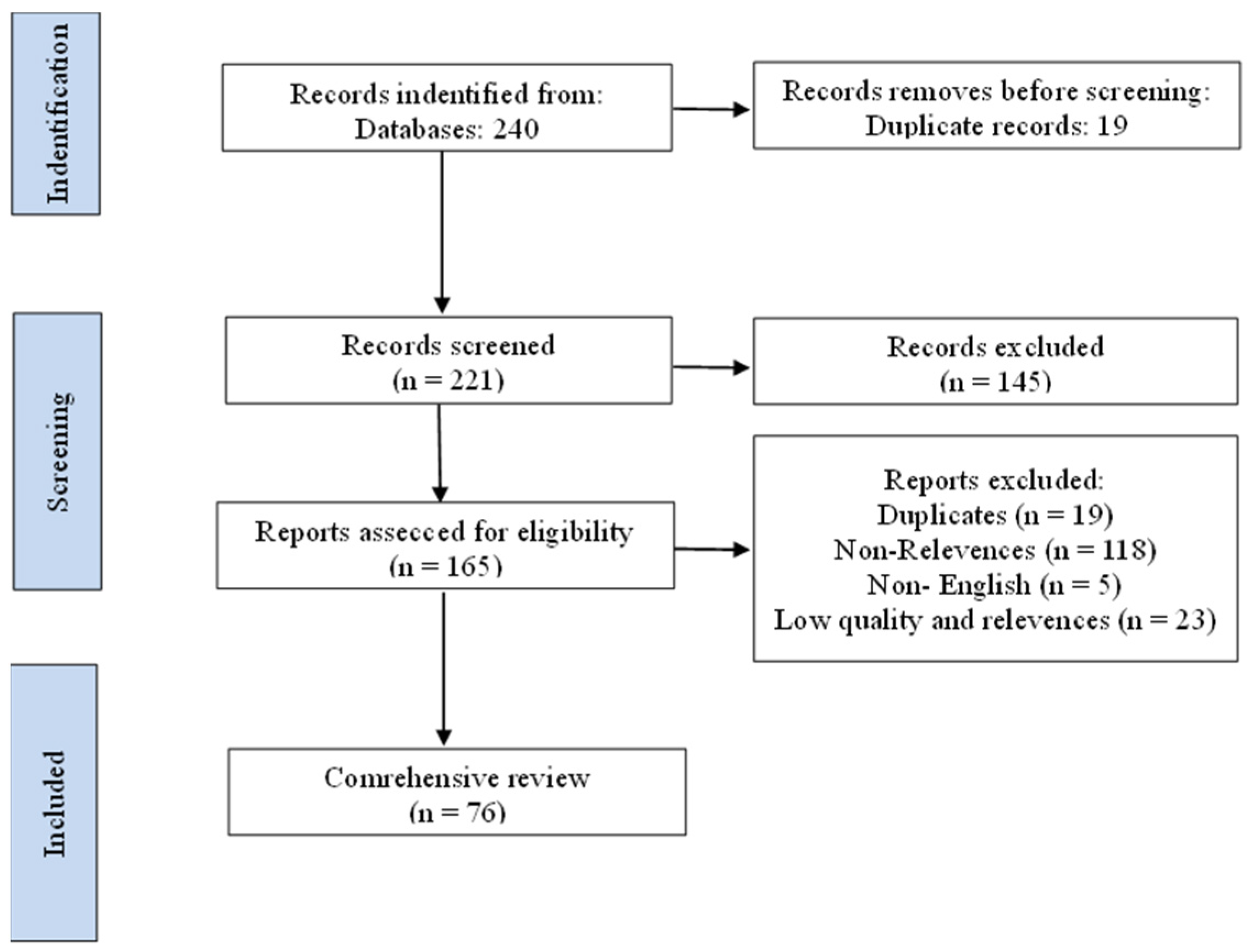
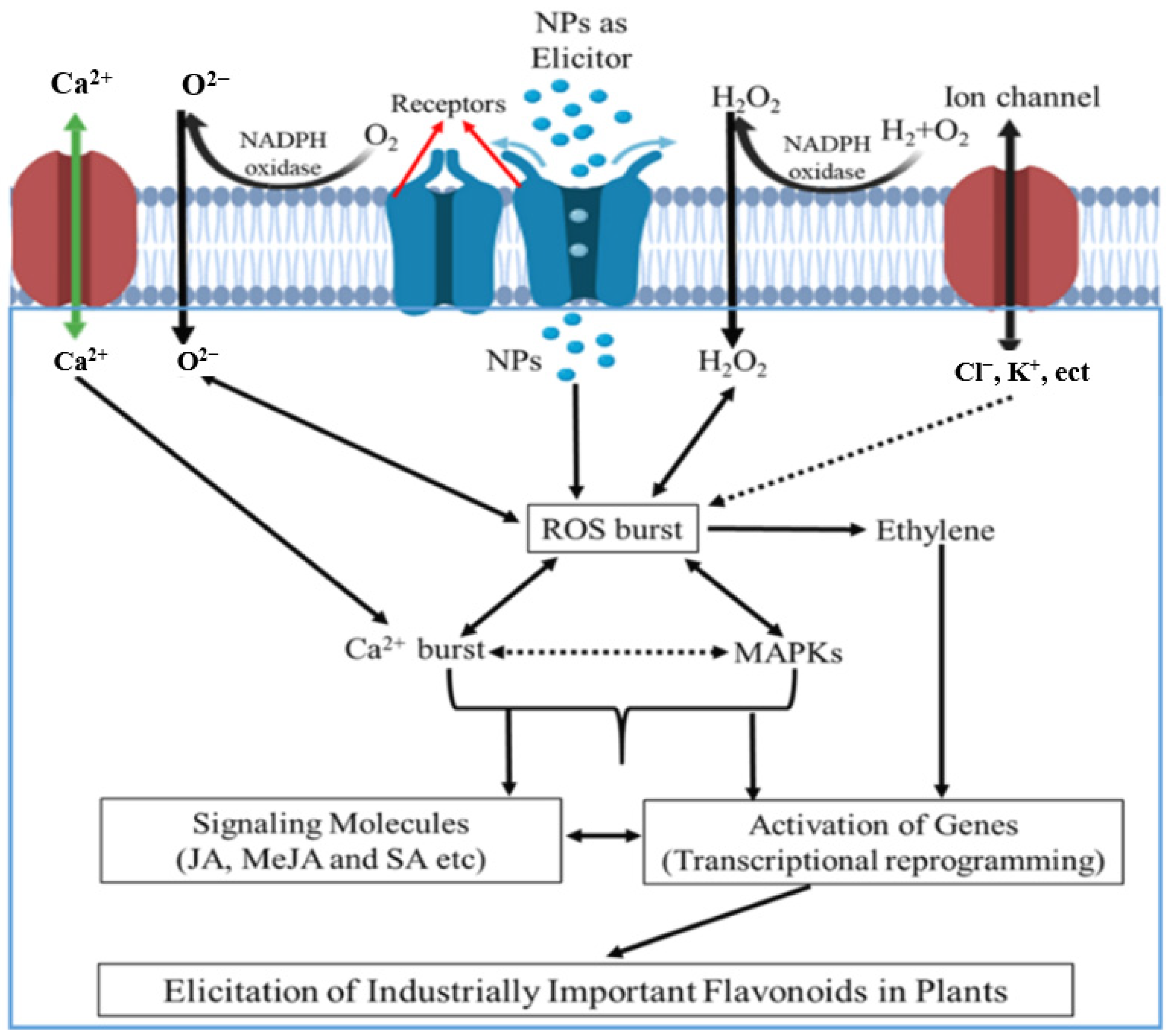
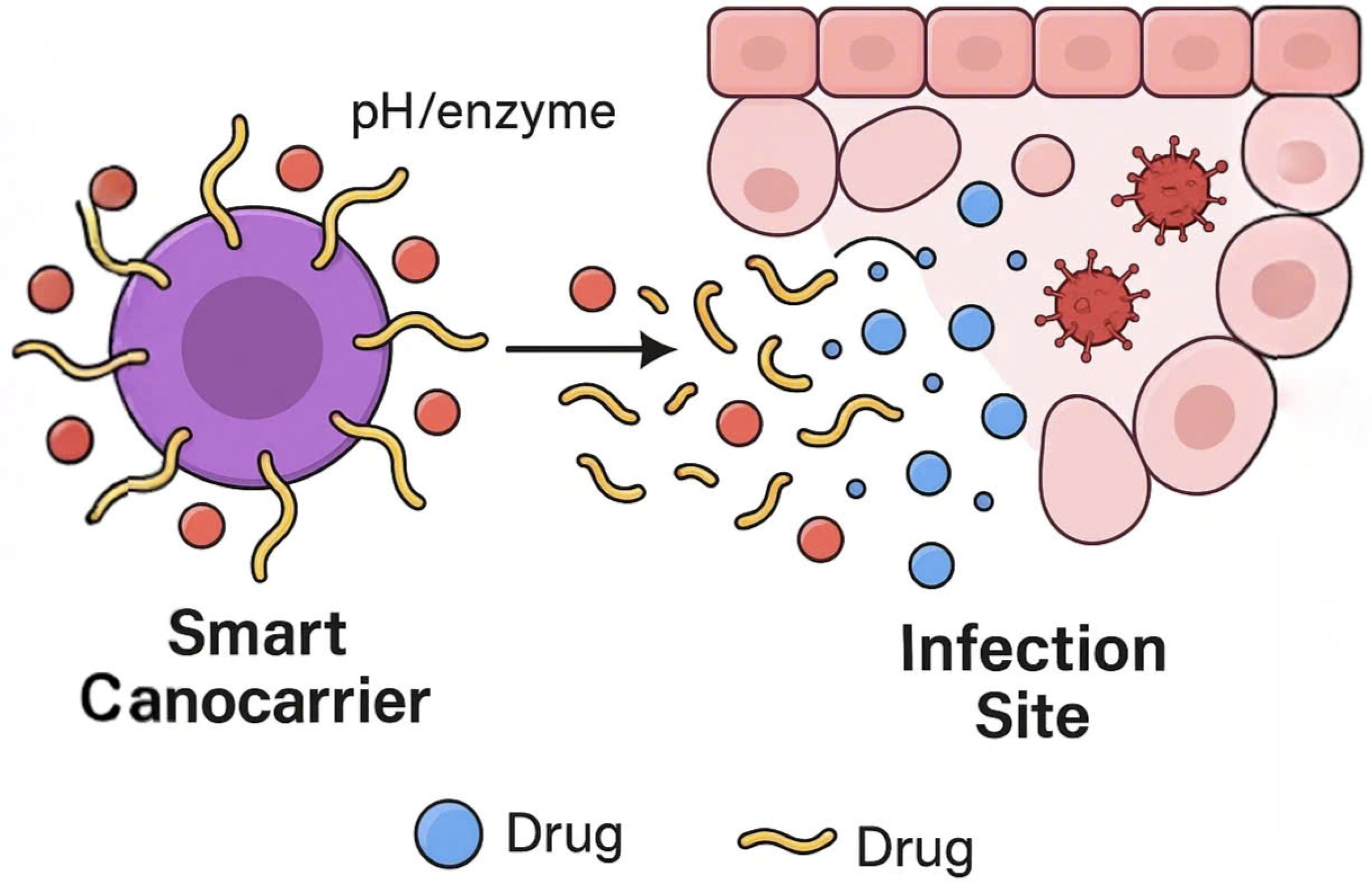
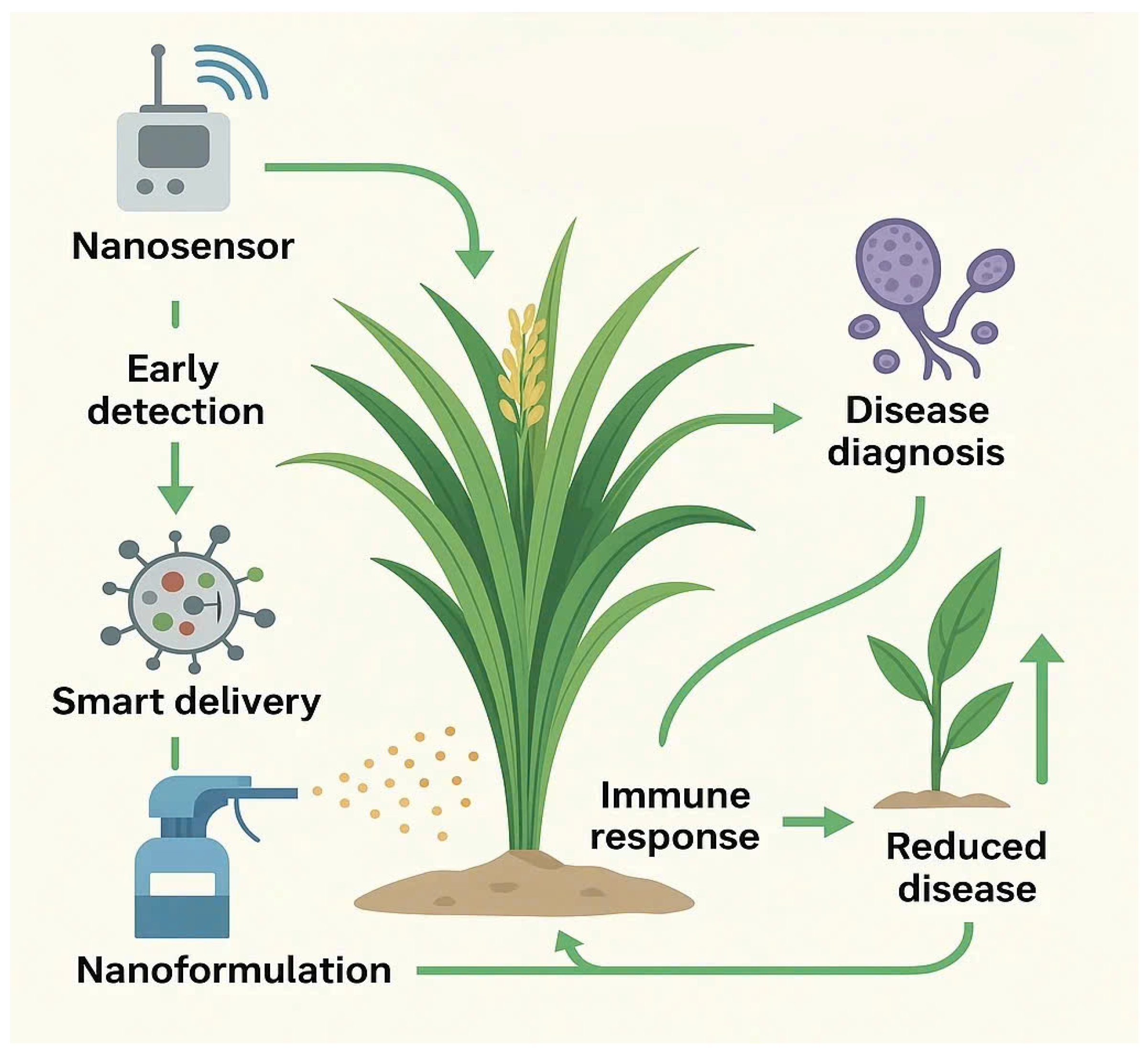
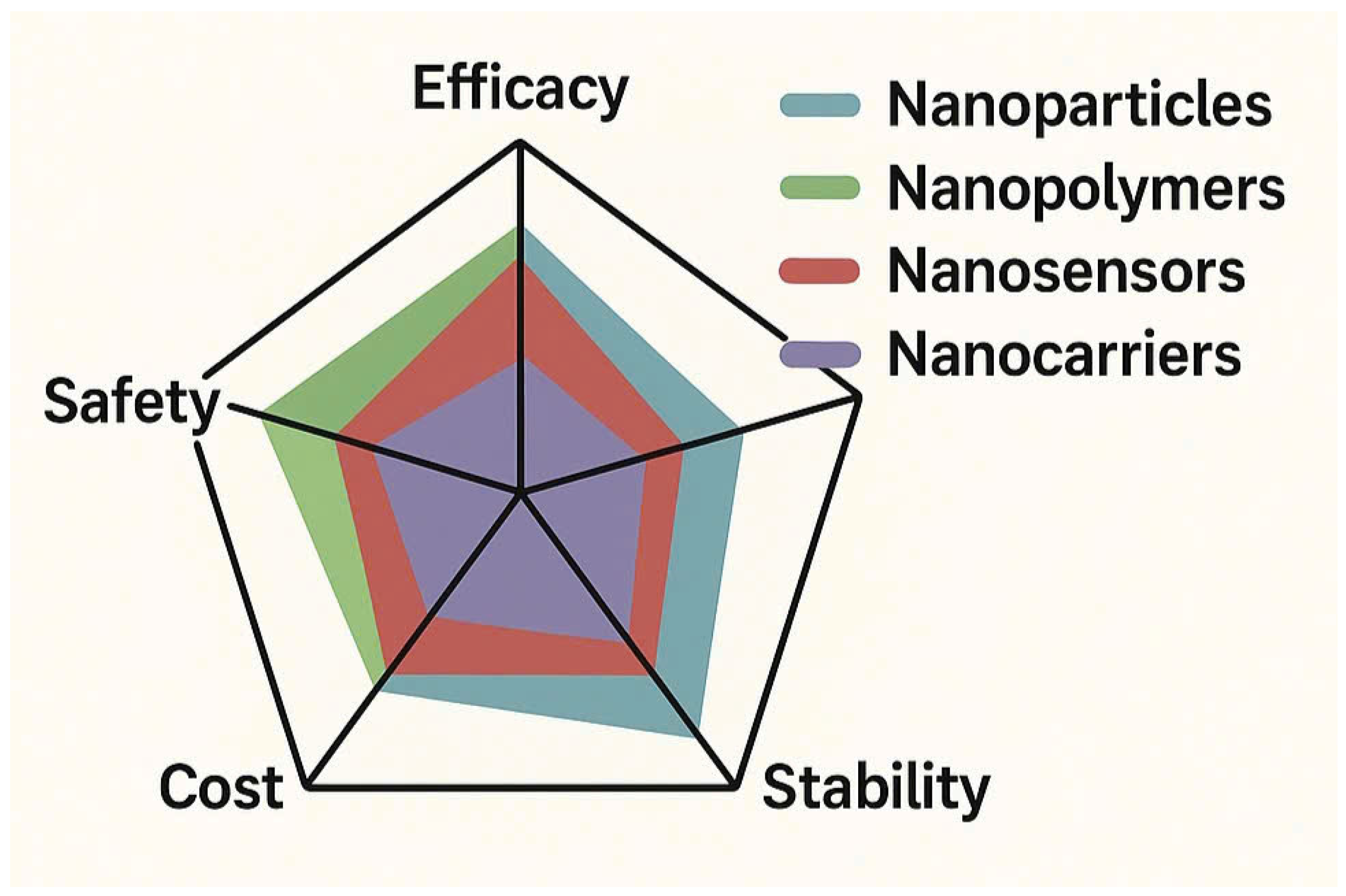
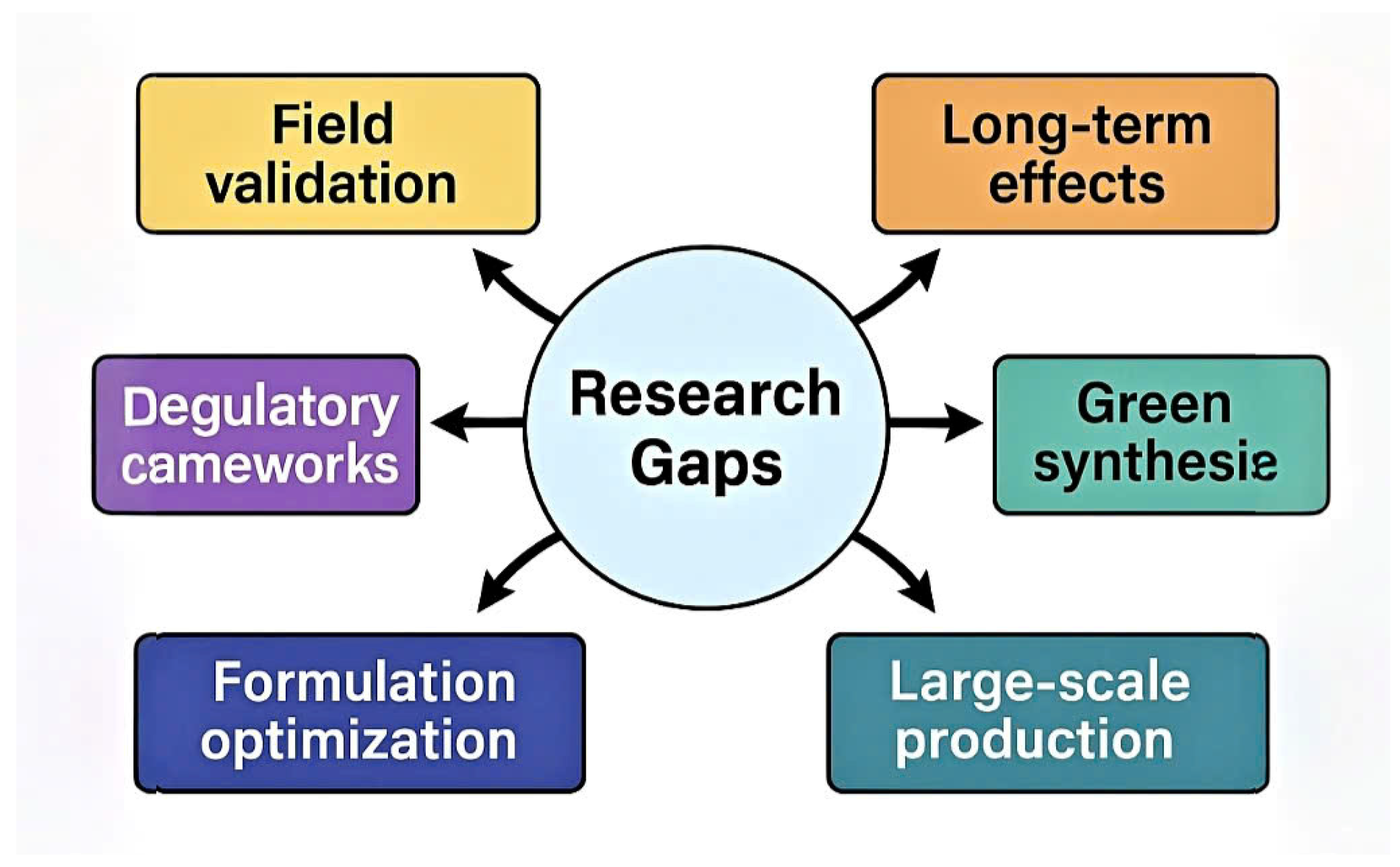
| Nanomaterial | Target | Effective Concentration | Effectiveness | Reference |
|---|---|---|---|---|
| AgNPs | Magnaporthe grisea | 800 ppm (in planta); EC50: 308.1 ppm (in vitro) | Reduced blast severity to 3.23% at 800 ppm; effective control under greenhouse conditions | [25] |
| CuO NPs | Magnaporthe oryzae (via OsCERK1 signaling) | Not specified | Enhanced basal resistance via modulation of antioxidant system and OsCERK1 signaling | [26] |
| AgNPs (20–30 nm) | Magnaporthe grisea | 100 ppm | Reduced lesion area to 15.3–26.7% compared to 80% in untreated control | [27] |
| AgNPs, AgNO3, AgCl | Magnaporthe grisea | Not reported | Inhibited fungal mycelial growth and suppressed colony formation | [28] |
| AgNPs, CuO NPs, ZnO NPs (Review) | General (focus on flavonoid production) | Not applicable (review) | Increased flavonoid biosynthesis in in vitro culture | [29] |
| ZnO Nano-Rice (HINRs) | Fungal spores (multiple species) | Not reported | Enabled rapid DNA extraction (≤12 min); enhanced detection sensitivity | [30] |
| Commercial AgNPs | Magnaporthe oryzae | EC50: 131.5 ppm; EC95: 276 ppm | Strong inhibition of mycelia, spores, and disease symptoms comparable to chemical fungicides | [31] |
| CuNPs | Phoma, Curvularia, Alternaria, and Fusarium spp. | Not reported | Inhibited growth of multiple phytopathogenic fungi | [32] |
| AgNPs (from rice leaf extract) | Rhizoctonia solani | 10–20 mg/mL | 96.7% mycelial inhibition and improved rice seedling growth | [33] |
| Cu–Cu2O/Alginate | Pyricularia oryzae | IC50 = 17.8 mg Cu/L | Reduced disease incidence to 9.38–18.54%, increased yield, and ensured low residue risk | [34] |
| ZnO NPs | Oryza sativa (growth enhancement) | 10–20 mg/L | Enhanced nutrient uptake, plant growth, and photosynthetic efficiency | [35] |
| TiO2 NPs | Oryza sativa (physiological development) | 5–20 mg/L | Improved plant height, yield, and enzymatic activity | [36] |
| Cu-Chitosan NPs | Pyricularia grisea (blast in millet) | 0.1% (w/v) | Protected 75% of plants, increased yield by 89%, and enhanced defense enzyme levels | [37] |
| Nano-silicon | Oryza sativa (phosphorus deficiency management) | Not reported | Reduced phosphate adsorption in cell wall by 26%, enhanced phosphorus uptake | [38] |
| Study Focus | Experimental Agent | Mechanisms and Pathways Involved | Principal Findings | Reference |
|---|---|---|---|---|
| Effects of cupric oxide nanoparticles (CuO NPs) on rice blast resistance | Cupric oxide nanoparticles (CuO NPs) | OsCERK1, ROS, MAPK, basal resistance | CuO NPs exhibit phytotoxicity but simultaneously enhance resistance to Magnaporthe oryzae through ROS regulation and activation of OsCERK1. | [28] |
| Role of OsNAC4 transcription factor in hypersensitive cell death (Hr) in rice | Avirulent bacterium (A. avenae N1141) | OsNAC4, OsHSP90, IREN, phosphorylation, HR cell death | OsNAC4 is a strong positive regulator of HR cell death, controlling plasma membrane integrity loss and nuclear DNA fragmentation. | [39] |
| Review of dual roles of nac transcription factors (Tfs) in plant immunity | NAC transcription factors (TFs) | Hormonal signaling (SA, JA, ET, ABA), ROS, PR genes | NAC TFs can act as positive or negative regulators of disease resistance; they integrate endogenous and exogenous signals across major crops like rice, wheat, and tomato. | [41] |
| Complete characterization of the salicylic acid biosynthetic pathway from phenylalanine in rice | PAL pathway (from phenylalanine to SA) | OSD1 → OSD4, BA-CoA, benzyl benzoate, cytochrome P450, carboxylesterase | The full PAL-SA pathway in rice was identified, involving four key genes; activation of this pathway increases SA levels and enhances plant immunity. | [40] |
| Sensor Type | Nanomaterials Used | Target Detected | Detection Limit | Application | Reference |
|---|---|---|---|---|---|
| Magnetically controlled electrochemical biosensor | PdNPs, magnetic beads, gold electrode | M. oryzae chitinase (Mgchi) | Pre-symptomatic stage | Early diagnosis of rice blast | [18] |
| ZnO-imidoester hybrid sensor | ZnO-imidoester (HINRs) | M. oryzae DNA | Not specified | Optical/electrochemical pathogen detection | [81,82,83] |
| g-quadruplex colorimetric biosensor | Hemin/G-quadruplex | Tetracycline (fungal toxin model) | 3.1 nM | Residue sensing (indirect fungal risk) | [15] |
| Type of Nanomaterial | Mechanism of Action | Antifungal Effectiveness | Advantages | Challenges/Limitations | References |
| Metallic Nps (Ag, ZnO, CuO) | Disrupt fungal membranes, generate ROS, release metal ions, trigger SAR | Strong inhibition of spore germination and appressorium formation | High efficacy, dual antimicrobial & defense induction | Toxicity to non-target microbes, accumulation in soil | [25,26,27,28,29,30,31,32,33,34,35,36,37,38,39,40,41,42,43,44,45] |
| Nanoemulsions of essential oils | Disrupt fungal structure, enhance antioxidant enzymes (POX, PAL, APX), SA signaling | Moderate to high; enhanced efficacy under UV and temperature stress | Biodegradable, eco-friendly, stable formulations | Environmental variability affects field performance | [46,47,48,49,50,51,52,53,54,55,56,57,58,59,60,61,62] |
| Nanochitosan/biopolymer nps | Fungistatic effect, act as elicitor, enhance phenolic and ROS response | Moderate; enhanced when combined with biocontrol agents | Biocompatible, suitable for seed coating, slow release | Limited penetration, potential formulation instability | [13,63,64,65,66,67,68,69,70,71,72,73,74] |
| Smart nanocarriers | Stimuli-responsive release (pH, redox), targeted fungicide delivery | High, with reduced fungicide dose (~50%) | Site-specific delivery, enhanced adhesion, reduced environmental load | High production cost, complex synthesis | [75,76,77,78,79,80] |
| Nanosensors/Nano-biosensors | DNA detection, pesticide residue sensing, real-time monitoring | High sensitivity and specificity; early-stage diagnosis | Portable, rapid, low-cost, field applicable | Limited commercial deployment, stability under field conditions | [15,18,81,82,83] |
| Silicon-based nps (sinps, cns, rha) | Strengthen cell wall, regulate defense genes (Lsi1), lignification | Moderate; also enhance stress tolerance | Enhance host resistance, improve abiotic stress response | Mechanism still under investigation, variable results | [37,46,84,85,86] |
| Nanostrategy | Efficacy | Safety | Cost | Stability | IPM Compatibility |
|---|---|---|---|---|---|
| Metallic nanoparticles | 3 | 1 | 2 | 3 | 2 |
| Nanoemulsions | 2 | 3 | 2 | 2 | 3 |
| Biopolymer nanoparticles | 2 | 3 | 2 | 2 | 3 |
| Smart nanocarriers | 3 | 2 | 1 | 3 | 2 |
| Nanosensors | 1 | 3 | 2 | 3 | 3 |
Disclaimer/Publisher’s Note: The statements, opinions and data contained in all publications are solely those of the individual author(s) and contributor(s) and not of MDPI and/or the editor(s). MDPI and/or the editor(s) disclaim responsibility for any injury to people or property resulting from any ideas, methods, instructions or products referred to in the content. |
© 2025 by the authors. Licensee MDPI, Basel, Switzerland. This article is an open access article distributed under the terms and conditions of the Creative Commons Attribution (CC BY) license (https://creativecommons.org/licenses/by/4.0/).
Share and Cite
Nguyen, P.V.; Darnetty; Lina, E.C.; Duong, N.V.; Ho, P.T.H.T.B.; Huỳnh, D.B. Nanotechnology for Managing Rice Blast Disease: A Comprehensive Review. J. Nanotheranostics 2025, 6, 23. https://doi.org/10.3390/jnt6030023
Nguyen PV, Darnetty, Lina EC, Duong NV, Ho PTHTB, Huỳnh DB. Nanotechnology for Managing Rice Blast Disease: A Comprehensive Review. Journal of Nanotheranostics. 2025; 6(3):23. https://doi.org/10.3390/jnt6030023
Chicago/Turabian StyleNguyen, Phuoc V., Darnetty, Eka Candra Lina, Nha V. Duong, Phuong T. H. T. B. Ho, and Di Ba Huỳnh. 2025. "Nanotechnology for Managing Rice Blast Disease: A Comprehensive Review" Journal of Nanotheranostics 6, no. 3: 23. https://doi.org/10.3390/jnt6030023
APA StyleNguyen, P. V., Darnetty, Lina, E. C., Duong, N. V., Ho, P. T. H. T. B., & Huỳnh, D. B. (2025). Nanotechnology for Managing Rice Blast Disease: A Comprehensive Review. Journal of Nanotheranostics, 6(3), 23. https://doi.org/10.3390/jnt6030023







